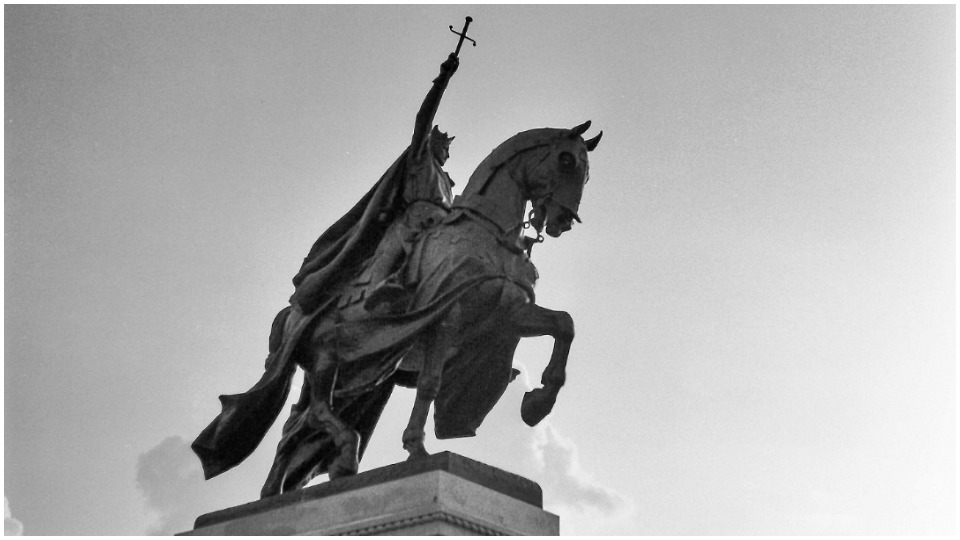
Littered throughout the annals of history are bits and pieces of chipped stone, melted down iron, bronze, copper, and the fine chalky gray sand that was once sculpting clay. They are the remnants of once stunning visual monuments, no longer relevant in some subsequent era or newly established political dynasty.
For as quickly as empires rise and fall—and fall they will—so too fall their monuments, statues, artwork, and gods.
In the vast deserts of Egypt, around 24 BCE, Queen Amanirenas of Kush and her vast armies invaded Roman territory, toppling the local governor. Her forces proceeded to unceremoniously chop off the head of a statue of Emperor Augustus. Becoming the soldiers’ prized possession, the sculpted head was brought back to their homeland, now Sudan, and buried deep beneath a staircase leading to their temple of victory. For over two millennia, the emperor’s head was trampled on by every person entering and leaving the temple—a lengthy humiliation for Caesar Augustus.
Iconoclasm, the commitment to destroying icons and monuments in art and architecture, dates back to antiquity, and the reasoning behind it is as varied as the wars, socio-economic changes, class struggles, and religious transformations plotting the course of history directly towards our modern era.
What we’ve typically gleaned from our history textbooks is that those who come into political power and establish new regimes—whether through force or by democratic means—tend to destroy (deliberately) the art and imagery installed by their predecessors—erasing their power, scrubbing clean any lasting influence.

This is “destruction from above,” the sanctioned erasure of visual history only granted by those holding political power. Of course, attaining power is sometimes the easy part. Maintaining it is the difficult part.
The masses, whilst not holding any political power in most social systems throughout history, can wield their political might, strategically when organized, and swiftly bring about change with the tools afforded to them—be it street murals, the tearing down of monuments, defacing the printed images of rulers, mass demonstrations, and on and on. This is “destruction from below.” And it is equally as powerful.
Oddly, the typical counterargument one hears when a monument is brought down during protest—“They are destroying a part of our history”—pops up most often when it’s destruction from below.
And according to some critics today, such “unsanctioned” destruction is the socially uncouth approach to fomenting political change.
But then, what’s that oft-repeated phrase? History is written by the victors. So, by that account, it does make a bit of sense.
“Off in the distance, the sounds of liberty bells ringing cuts through the air, and is carried upon a breeze. A cheer echoes throughout New York City. Soldiers rush off to the foot of Broadway at the Bowling Green. Ropes are grabbed by every able hand. A few moments pass as the knots are tied. Slowly rising into a boisterous crescendo, “One…two…heave,” the statue of King George the Third, the colonists’ tyrant, comes crashing down off of its marble pedestal. It is July 9, 1776, and the Declaration of Independence has just been read aloud.”
The smell of blood and rot accompanied by the acrid stench of gunpowder would mark the next years of the revolution until the surrender of British Gen. Charles Cornwallis to Gen. George Washington at Yorktown on October 19, 1781.
In that moment of history, it was the colonists who were victorious. But, before victory, they did nothing but exercise their might through “destruction from below.”
And if one were to ask crown loyalists what they thought of such an act, we would hear descriptions of disrespect for the law, violence, and destruction—almost word for word what we hear today when a crowd protests or pulls down a statue.
The murder of George Floyd by four former Minneapolis police officers was a catalyzing moment for the United States, and the demands for accountability, an end to police brutality, systemic racism, and a complete overhaul of American politics quickly spilled out onto the streets nationwide.

And a central part of this national self-reflection is re-examining the presence of national monuments commemorating individuals who were central in the short-lived attempt to maintain chattel slavery under the (debunked) guise of liberty and states’ rights: the Confederate States of America.
As mentioned before, the news coverage of the peaceful demonstrations—with a few questionable actors acting selfishly—shifted in rapid succession from images of non-violent civil disobedience to property destruction and looting.
Was this done by major news outlets on purpose and for political reasons? Maybe. We can’t be fully sure. Of course, we can be sure it was done for the sake of drama, excitement, and viewership. Conflict sells.
And many of the images we saw were of demonstrators tearing down or defacing Confederate monuments. Those actions were accompanied by renewed calls to remove those monuments honoring traitors and controversial figures like Christopher Columbus.
In the headlines, in conversation with friends and family members, and sometimes, not as often during our pandemic season, strangers, when the topic of monument removal comes up, it inevitably prompts such statements as:
“It’s an attempt by the left to erase history.”
“It dishonors the memory of those who died fighting for the Confederacy.”
“It’s our heritage.”
On the surface, they may seem like legitimate concerns, on the point of erasing history, but if you dig a bit deeper you realize that the Civil War’s history will still be there, it isn’t going anywhere, and all that is happening is the removal of individuals who vehemently upheld anti-democratic views.
Or as put by Harvard historian of U.S. slavery and legal scholar Annette Gordon-Reed: “History will still be taught. We will know who Robert E. Lee was. Who Jefferson Davis was. Who Frederick Douglass was. Who Abraham Lincoln was. There are far more dangerous threats to history. Defunding the humanities, cutting history classes and departments. Those are the real threats to history.”

History’s filled with troubling individuals. Human beings are imperfect. And there is nothing wrong with reviewing their place in history; moving monuments to museums still maintains their public accessibility but adds more nuanced context to their role in that history.
There is no perfect solution when it comes to monuments and where they belong. It is left up to public discourse, and subject to a democratic outcome.
In the case of the United States, the removal of Confederate monuments, those visual remnants of white supremacy and slavery, should be taken down. They serve no purpose other than to glorify a past we are desperately trying to correct.
And, again, why would we honor traitors?














